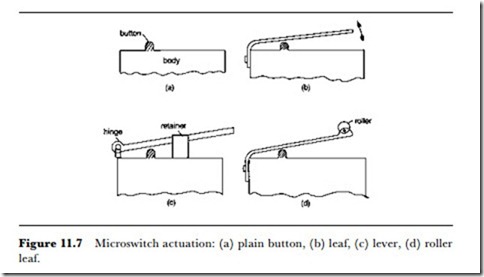Rotary and key action
The most common type of rotary switch is the wafer type (this is dealt with in the following chapter along with other signal circuit switches), but for more specialized purposes rotary mains switches are available. A rotary action switch is often found incorporated into a potentiometer, providing the combined onjoffjvolume control action that was very common at one time for mains radios and TV receivers, and is still found on some audio equipment. Separate rotary action mains switches are still available, but mainly for replacement purposes. One modern type is intended to discourage casual use by having a shaft with a screwdriver slot, but the main use for rotary mains switches in supply circuits nowadays is to permit key action for security purposes. The variations in key mechanism include removable or trapped keys, and common or random key patterns. The use of a trapped key allows a circuit to be switched on by a keyholder, but since the key must then remain in the switch the equipment can be switched off by anyone, as safety regulations will usually stipulate. If the key can be removed, some other switch-off mechanism in the form of an emergency button should be provided.
Microswitches
The microswitch is a component with a comparatively short history but a rapid development in use. The ‘micro’ part of the title is slightly misleading
– these switches need not be particularly small physically (although some are) and often have contact areas as large as conventional toggle switches. The distinguishing feature of a microswitch is its toggling action, which calls for a very small amount of movement of the actuating button or lever. For a basic microswitch operated directly, the movement will typically be 0.4 mm before contacts are changed over, with a differential of 0.05 mm. The differential is the minimum change in operating-pin position between on and off, and it is this quantity in particular that is responsible for the name of the switch. The mechanism also permits the operating pin to move beyond the position required for switching over, typically 0.l5-l.5 mm depending on type. These small actuating movements are achieved along with voltage and current ratings of mains standard – typically 480 V, l5 A. The microswitch itself is operated by pushing a pin of small diameter (typically l.5 mm), so environmental sealing is much easier than it is with other types. In addition, a variety of external mechanisms can be used to actuate the pin. The operating forces call for quite high pressures on the pin of a conventional microswitch, so that the external addition of buttons, plain levers, and roller-arm levers (Figure ll.7) all make operation easier. The plain pin type is used for door interlock switching, and in any other application in which other moving parts can apply pressure directly. By using push buttons, operation by finger pressure is made easier; by using levers, lighter action at the expense of larger amounts of movement can be achieved.
Types of low-torque microswitch can be obtained, allowing mains switching at up to 5 A, but with such low torque operation that the action can be initiated by a small vane blown in an airstream, the weight of a coin, and so on. For use with signals or with low voltage supplies, subminia- ture microswitches can be obtained that combine very small size with the usual short operating travel, and in this case with small amounts of force as well.
The main applications for microswitches when they originally appeared were as door safety switches and alarm systems. The action is always of the momentary variety, so that microswitches are employed as main unit switches only in conjunction with hold-on relays, since there is no latching action in the microswitch. This has not deterred the rapid spread in the use of microswitches, some with mechanical latching mechanisms attached externally. One important factor must be the expected operating life of a microswitch, which is very long: about l0 million operations. This greatly exceeds the expected operating life of most toggle switches. Add to that the better sealing from external atmospheres and the high contact ratings that are available, and it is not difficult to see why microswitches are so often specified for actions that have nothing to do with door switching or security.
